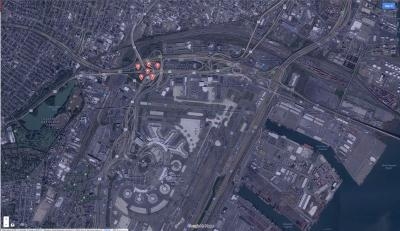New Jersey DOT To Inspect Light Mast Poles Near Newark Airport
The New Jersey Department of Transportation (NJDOT) is embarking on one of the first legal drone operations ever authorized in the busy Newark, New Jersey, airspace, opening up numerous possibilities for future official use of unmanned aircraft systems (UAS, or drones).

The department contracted with S&R Engineering and Principia Inc., a professional New Jersey drone operator, to inspect high-mast light poles. Principia was approved by the FAA for a Part 107 Waiver to operate tethered drones within Newark's Class Bravo Airspace.
Flying drones near any airport is complicated, much less Newark Liberty International (KEWR), one of the busiest in the country. So a number of safety measures are being taken in advance.
"NJDOT ensured our crew had successfully inspected dozens [of] poles before considering working near Newark Airport," says NJDOT Bureau of Aeronautics UAS Coordinator Glenn Stott. "We then coordinated with the FAA and Newark Liberty International Airport management to minimize any potential impact for the airport. As a result of our preparations, the FAA approved a tethered operation to a maximum altitude of 100 feet."
To further reduce the chances of traffic congestion around the airports, the drones will only fly on the weekends, Stott says.
Using the drones could actually improve roadway traffic for area commuters by simplifying the pole inspection process and making it safer.
"High-mast light poles are 100 feet high, so inspections were normally conducted with a bucket truck that lifts an inspector to visually inspect the pole, or by using binoculars from the ground," Stott says. "Using these large bucket trucks also can require a lane closure if the pole is very close to the roadway.
"Using an inspection drone eliminates the requirement for personnel high in the air, requires a smaller crew, and reduces possible lane closures, making this technology both safer, more efficient, and less of a burden on the public," Stott says.
Implementing the project involved coordination between NJDOT and multiple national and regional organizations. Drone operations can potentially interfere with manned aircraft and are therefore prohibited from flying in Class B airspace without FAA authorization. NJDOT must also ensure that management at the airport and at the Port Authority of New York and New Jersey are informed of the intended operation and aware of the FAA authorization.
"They need to know where we are and have the ability to communicate with the drone crew if necessary," says Stott.
The U.S. Department of Homeland Security and local law enforcement agencies also need to be aware of the project, as they may receive reports of drones flying near Newark Airport.
The first light pole inspection has not yet been scheduled, but safety planning is in process. NJDOT uses only experienced, FAA-certified professional remote pilots, all of whom also have significant fixed-wing flying experience.
"We also require a safety observer for all flights. Our remote pilots must complete a detailed series of communication and flight control checks immediately prior to every flight," Stott says.
The drone crews will never fly directly over a roadway or near vehicles. Additional precautions will include:
- Testing the equipment by flying several flights in accordance with the special FAA authorization for Class B airspace
- Adding a fourth crew member for Class B operations to operate the tether system
- Analyzing aviation weather forecasts before each flight.
The project has the potential to open up new avenues for official drone operations in the state's transportation system, Stott says.
"The general public is just starting to realize the many benefits of professional UAS operations for New Jersey," Stott says. "This is an emerging civilian industry that offers good-paying jobs in applications such as structural inspections, project management, emergency response, and aerial photography. We see many potential areas in transportation where utilizing UAS technology makes sense."
(Source: NJDOT. Image provided)
 ANN's Daily Aero-Linx (05.02.24)
ANN's Daily Aero-Linx (05.02.24) ANN's Daily Aero-Term (05.02.24): Touchdown Zone Lighting
ANN's Daily Aero-Term (05.02.24): Touchdown Zone Lighting Aero-News: Quote of the Day (05.02.24)
Aero-News: Quote of the Day (05.02.24) ANN FAQ: Contributing To Aero-TV
ANN FAQ: Contributing To Aero-TV NTSB Final Report: Cirrus Design Corp SR20
NTSB Final Report: Cirrus Design Corp SR20



